Hinchingbrooke Country Park
Huntingdonshire Fauna & Flora Society, Mini Bioblitz July 2019
A mini-BioBlitz carried out by the Huntingdonshire Fauna and Flora Society on 10th July 2019 between 2.30 to 4.30pm provided an opportunity to assess the status of some elements of the flora and fauna of the Park. The plant species list for the Country Park is extensive. A total of 291 taxa have been recorded since 1989. In 2003 the HFFS report included a list of 189 of which 159 were rerecorded in 2019 (i.e. 30 were unrecorded). Most of the ‘missing’ species are common and likely to have been overlooked. In 2019 members of the Society recorded 260 taxa, including 101 ‘new’ records (i.e. not recorded in earlier surveys). Overall this result suggests that there has been a real increase in plant species diversity since 2003. The grassland and marginal vegetation around the lakes are considered in this note, but surveys were also undertaken of the woodland areas, including a fungus foray in October. These data will be augmented with records from the Cambridge and Peterborough Environmental Record Centre and personal records by HFFS Chair who has been visiting the site for more than 30 years. Further, more detailed analysis will be attempted in relation to the different vegetation management zones.
Three zones are noteworthy of special comment:
Zone P including the pond-dipping area. The pond has a good variety of Dragonflies and Damselflies including some of the following, recorded in 2018 from the whole of the CP by Mick Twinn:
| Azure Damselfly, Coenagrion puella; Banded Demoiselle, Calopteryx splendens; Blue-tailed Damselfly, Ischnura elegans; Common Blue Damselfly, Enallagma cyathigerum; Common Darter, Sympetrum striolatum; Emerald Damselfly, Lestes sponsa; Hairy Dragonfly, Brachytron pratense; |
|
Large Red Damselfly, Pyrrhosoma nymphula; Migrant Hawker, Aeshna mixta; Red-eyed Damselfly, Erythromma najas; Ruddy Darter, Sympetrum sanguineum; Scarce Chaser, Libellula fulva; Variable Damselfly, Coenagrion pulchellum; Willow Emerald Damselfly, Chalcolestes viridis; |
This grassland has a wealth of plants but is especially good for invertebrates. During the July survey the grassland area east of the pond was full of butterflies, the following noted by Pam Peacock and others:
| Meadow Brown, Maniola jurtina (33 Indivs); Small Skipper, Thymelicus sylvestris (8 indivs); Essex Skipper, Thymelicus lineola (3 indivs); Common Blue, Polyommatus icarus (2 indivs); Ringlet, Aphantopus hyperantus (2 indivs); |
Large Skipper, Ochlodes sylvanus (1 indiv); Marbled White, Melanargia galathea (1 indiv); Large white, Pieris brassicae (1 indiv); Comma, Polygonia c-album (1 indiv). |
The southern section of Zone Q, opposite the hide overlooking Lake Zone I included rough wet grassland plants such as Ragged-Robin. In 2019 colonies of two Orb Spiders: Wasp Spider Argiope bruennichi and Four-spotted Orb Weaver Araneus quadratus were found. The former a relatively recent colonist from the European continent, the latter our largest spider. The egg cocoons, often containing several hundred eggs, overwinter in the higher parts of the vegetation, hatching in the following spring. Cutting grassland, even during the autumn, winter or spring, adversely affects the survival of the spider.
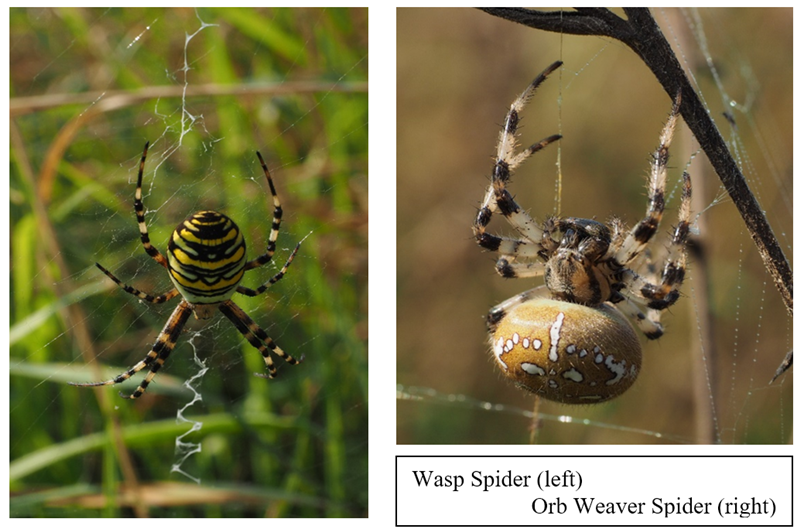
Zone H lies almost entirely in Brampton Parish and was surveyed during 2013/14 as part of the Brampton Biodiversity Project. Although not included as one of the ‘Hot Spot’ reports at the time, more recent surveys suggest that it should have been. The zone includes examples of all the habitats present in the Park, with transitions between each. Alconbury Brook has several interesting species, including: Arrowhead, Sagittaria sagittifolia restricted to the main river systems and Water Horsetail, Equisetum fluviatile sparsely distributed in Huntingdonshire.
Zones M and N the woodland areas, including Bob’s Wood, were surveyed for Fungi on the 13th October (see HFFS News item). This produced one of the longest lists of fungi the Society has recorded. The list was compiled by Richard Shotbolt and included 104 unique taxa. The following note was prepared by Gordon Wyatt who found an individual of the Leptoglossus occidentalis during the survey.
“A Western Conifer Seed Bug was identified by Gordon Wyatt. The bug is a Nearctic leaf-footed pine bug which has recently arrived in the UK. It is a native of North America where it is a relatively serious pest in conifer seed nurseries particularly affecting Douglas fir (see HFFS News/Records).
It was first detected in Britain in 2007 found in Weymouth College, Dorset. Since then it has quickly spread around the south of England and up into the midlands, south Wales and west Yorkshire.
It was accidentally introduced to northern Italy in 1999 and has spread rapidly being recorded in Switzerland (2002); Spain and Slovenia (2003); Croatia and Hungary (2004); Austria (2005); Germany, France, Serbia and the Czech Republic (2006).
They feed on the flowers, cones and seeds of conifers including Scots pine and other pine trees, Douglas fir, spruce and cedar. The female can lay up to 80 eggs in May/June. The nymphs feed on the tender shoots and go through five stages of development before becoming an adult in late August.
The bug does not bite or sting and does not carry any known diseases.”
Copies of the report and detailed species list are available from This email address is being protected from spambots. You need JavaScript enabled to view it., Chair Huntingdonshire Fauna & Flora Society, who collated the data in 2019.
 In 2016 the Society decided to celebrate the 70th Anniversary (in 2018/19) with the publication of a book on local orchids from Huntingdonshire and the Soke of Peterborough. The project was managed by a small team of members, Barry Dickerson, Lynne Farrell, Roger & Sarah Orbell and Peter Walker. After three years of research and field work the book was published in 2019.
In 2016 the Society decided to celebrate the 70th Anniversary (in 2018/19) with the publication of a book on local orchids from Huntingdonshire and the Soke of Peterborough. The project was managed by a small team of members, Barry Dickerson, Lynne Farrell, Roger & Sarah Orbell and Peter Walker. After three years of research and field work the book was published in 2019.
HFFS Members and the public provided details of orchid sites, members of the project team visited known and possible orchid sites, collected grid references and took photographs for use in the book. Museums, herbariums, literature, record centres and natural history societies were all consulted to gain information; many land owners gave us access to their land to search for Orchids. All records were catalogued and the data used to create distribution maps.
The contents include historical data and details of some early botanists who recorded orchids. Descriptions of the geology, soil and habitats of the study area are included. Reports on several past and current monitoring projects are also presented. Basic botanical details of orchids are explained and each of the local Orchid species has a section that includes background information, local data including maps and a description with photographs. Orchid sites with Public access are also listed.

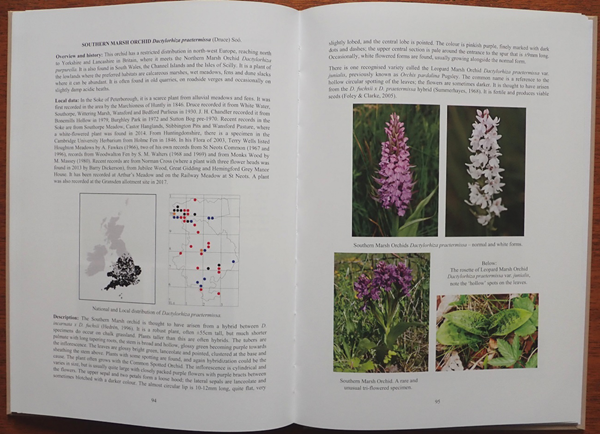
THE BOOKS ARE HARDBACK PRINTED IN COLOUR.
PRICE £20 + £3 POST AND PACKAGE
CHEQUES PAYABLE TO: The Huntingdonshire Fauna & Flora Society.
CONTACT: P. WALKER. 6 ANDREW Rd, EYNESBURY, ST NEOTS. PE19 2QE
Just a sample of the many photographs taken by Pat Doody
HINT: Click on a photo to enlarge
WANTED: all records of Butterflies and Moths found in the county of Huntingdonshire. A book is being written about the Butterflies and Moths of Huntingdonshire, which it is planned to be published in 2020.
BUTTERFLIES:
There are many gaps on the distribution maps of some of our common butterflies; species that should be recorded in all areas. I have visited most areas myself but cannot cover every area in the county at the right time, that is, when each butterfly species is on the wing, to record them all, so I am asking for your help. I require records of every species, lists from your garden are just as important as others, so please make a list of any butterflies that visit your garden and send them to me. Also, when you are out and about in Huntingdonshire and see a butterfly make a note of the species, where seen and the date. If you can give me a four-figure grid reference or post code, if available, that would be appreciated, so I can make sure the record is placed in the right area. As an example, sites like Brampton Wood and Monks Wood cover four recording squares (tetrads), so to plot the position of a record on a map I need the area of the wood the record was made: i.e. four figure grid reference. However, don’t let this put you off sending in records because I can usually sort out where the record has been made with a little help from you.
KNOWN DISTRIBUTION OF ORANGE-TIP BUTTERFLY:
The map below shows the distribution of the Orange-Tip butterfly, a very easy species to record. The red dots are the most recent records. As can be seen from the blank areas on the map there are many sites where this species has never been recorded.
Please send any records to This email address is being protected from spambots. You need JavaScript enabled to view it.
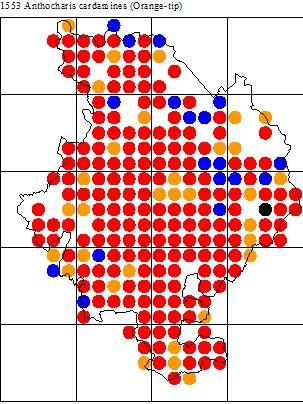 |
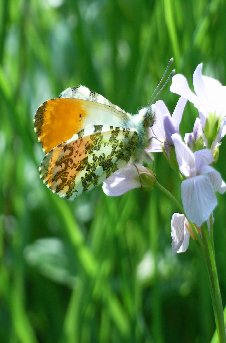 |
KNOWN DISTRIBUTION OF HOLLY BLUE BUTTERFLY:
Map showing the distribution of the Holly Blue. A species that is a regular visitor to gardens in May and August.
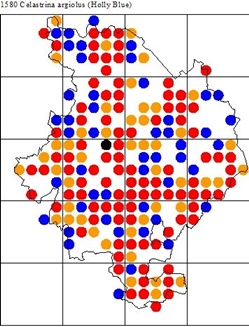 |
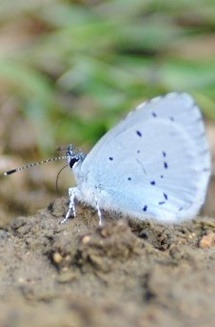 |
MOTHS:
Recording the moths is more specialised than recording the butterflies, but everyone can still help with some species. There are several species that are often found in houses, such as the Brown House-moth and White-shouldered House-moth. Most people squash them when they see them. What I am asking is that you place them in a pot and put them in your freezer for a couple of hours. This will kill them, but keep them in good condition for me to identify. You can then either photograph them and e-mail me the picture or save them and hand them to me at a later date – perhaps at a HFFS meeting. If you intend to store them to hand to me later keep them dry, so they don’t get attacked by mould and also be aware of other insects that may eat them like museum beetle larvae. I require the same details as with the butterflies, where found and the date, so they can be plotted on the maps. I also want any other records of moths you are able to identify or are willing to collect or photograph and e-mail to me for identification, that you may see in your garden or while out and about. Silver Ys are very common some years, but like some species of butterflies are not recorded from many areas.
KNOWN DISTRIBUTION OF BROWN HOUSE MOTH:
The map below shows the known distribution of the Brown House-moth, a moth that most probably occurs in every house in the county. The red dots are the most recent records, so from this map you can see how under-recorded this species is.
 |
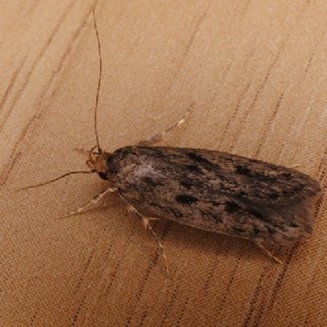 |
KNOWN DISTRIBUTION OF SILVER Y:
The map below shows the known distribution of the Silver Y, a very common migrant moth that is also greatly under-recorded.
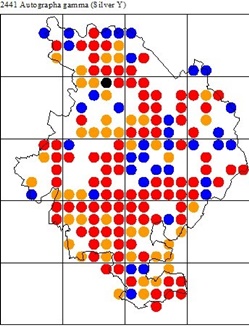 |
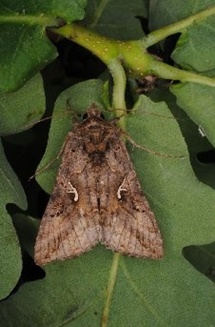 |
From time to time the Society undertakes projects either of its own volition or on behalf of others. Collating records and undertaking surveys of sites and species, has resulted in reports contributing to:
Books:
Detailed projects have resulted in important books, which are available to purchase (see Publications):
2003 - The Flora of Huntingdonshire and the Soke of Peterborough by Terry Wells;
2005 - Brampton Wood, A Natural History by the Huntingdonshire Fauna and Flora Society, produced by a group of HFFS members, each contributing to their speciality subject;
Other surveys
Reports contributing to:
2016 the Brampton Parish Biodiversity Project
Between 2014 and 2015 members helped survey a number of individual ‘hot spots’ in Brampton Parish. Individual reports can be viewed on the National Biodiversity Network web site. See in particular reports for - Brampton Park Golf Club; St Mary Magdalene Churchyard and River Lane Pits.
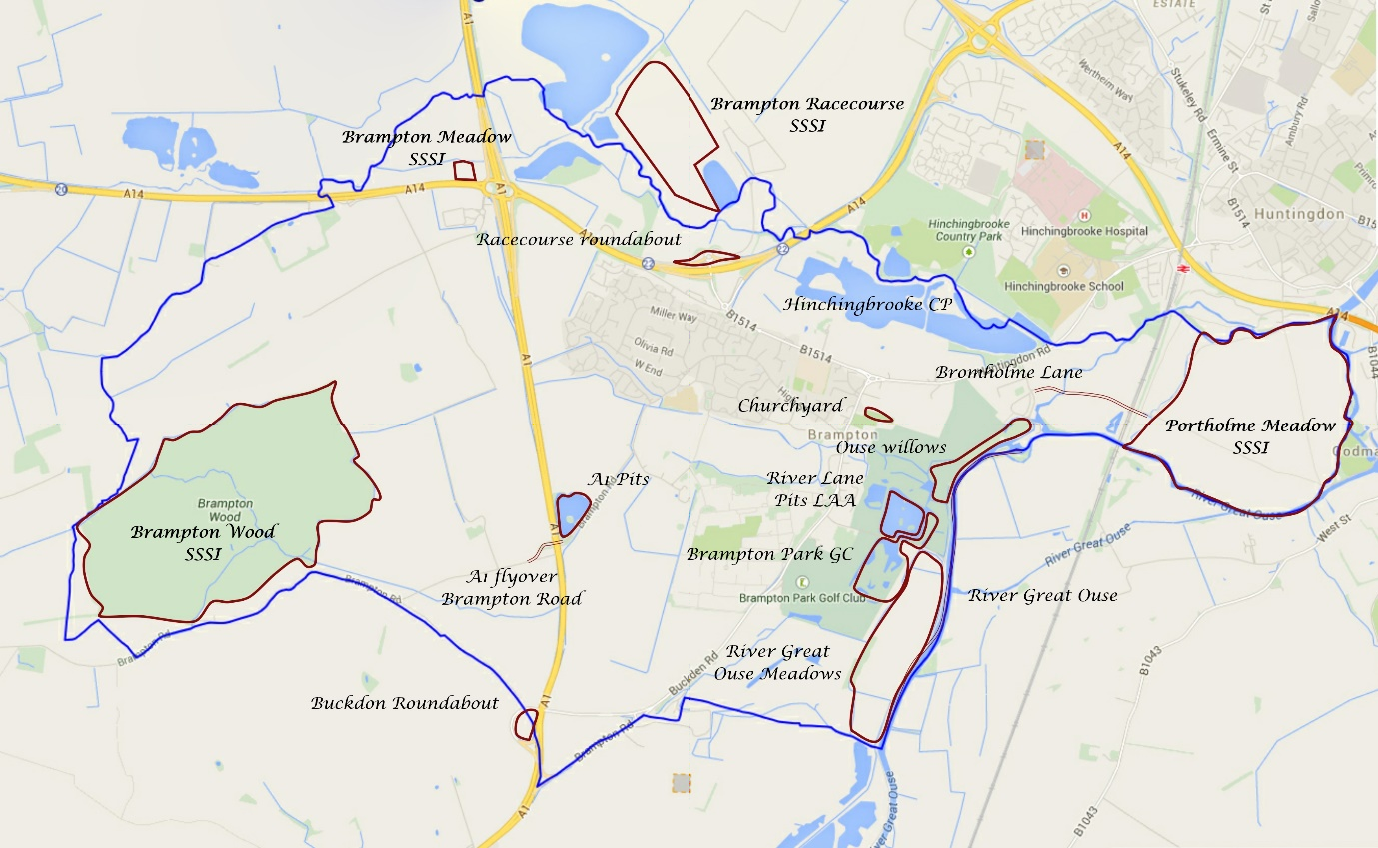
Location of all the biological ‘hot spots’ in Brampton Parish, Huntingdonshire District
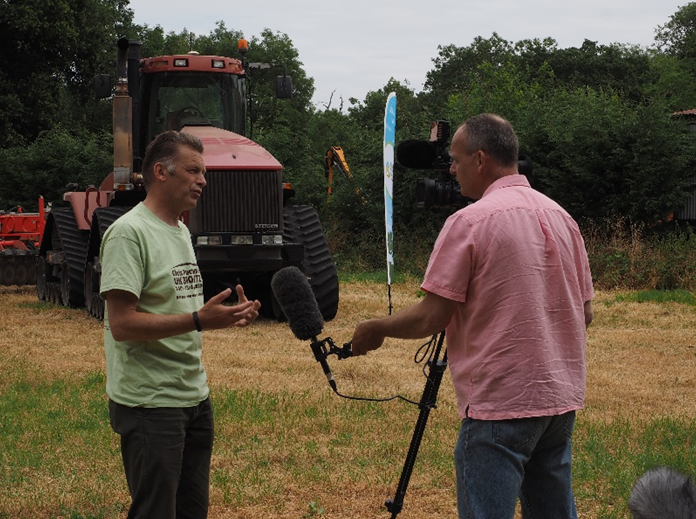 2018 - Chris Packham’s UK Bioblitz - Nature Reserves Are Not Enough!
2018 - Chris Packham’s UK Bioblitz - Nature Reserves Are Not Enough!
In July 2018 Chris and his team of experts visited 50 wildlife sites around the UK to highlight the extent to which the nation’s wildlife is under threat. These included a ‘Nature friendly Farm’, near Papworth Everard when two members (HHFS and Wildlife Trust Hunts. Local Group) helped survey the plants on the farm.
2019 - At the request of members of Great Gidding Parish Council, in June we surveyed Jubilee Wood. Just over a hectare of new woodland (planted in 2002) this was established on waste ground. The wood is owned by the Parish Council which, with the guidance of the Forestry Commission, planted a mix of indigenous trees such as oak and ash to celebrate the Queen’s Golden Jubilee in 2002.
2019 Hinchingbrooke Country Park
Currently the Society is collating the results of previous surveys of Hinchingbrooke Country Park from 2003. In August 2019 we carried out a resurvey of some elements of these surveys to update the information on the park. This will help with management decisions in the future.
Current and recently completed Projects are:
2019 - The Orchids of Huntingdonshire and the Soke of Peterborough by Barry Dickerson, Lynne Farrell, Roger & Sarah Orbell and Peter Walker.
2019 – 2020 The Lepidoptera Project, Barry Dickerson.
If you are interested in taking part in any further studies please contact the Chair, Dr Pat Doody, This email address is being protected from spambots. You need JavaScript enabled to view it..
Page 2 of 3



